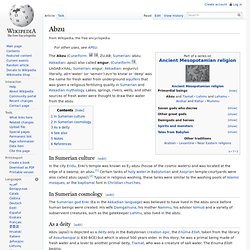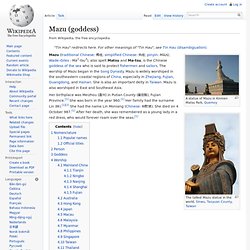

Abzu. For other uses, see APSU.

The Abzu (Cuneiform: 𒍪 𒀊, ZU.AB; Sumerian: abzu; Akkadian: apsû) also called engur, (Cuneiform:𒇉, LAGAB×HAL; Sumerian: engur; Akkadian: engurru) literally, ab='water' (or 'semen') zu='to know' or 'deep' was the name for fresh water from underground aquifers that was given a religious fertilizing quality in Sumerian and Akkadian mythology. Lakes, springs, rivers, wells, and other sources of fresh water were thought to draw their water from the abzu.
In Sumerian culture[edit] In Sumerian cosmology[edit] Amathaunta. Anahita. Statue of Anahita in Maragha, Iran.

Anahita[pronunciation?] Apam Napat. In Yasht 19 of the Avesta Apąm Napāt appears as the Creator of mankind.

Here, there is an evident link between the glory of sovereignty (Khvarenah) and Apąm Napāt who protects Khvarenah as the royal glory of Iranian kings. Apām Napāt is sometimes, for example in Rigveda book 2 hymn 35 verse 2, described as the supreme creator deity who originates in the cosmic waters (see: Agni). Apam Napat has a golden splendour and is said to be kindled by the cosmic waters. The reference to fire may have originally referred to flames from natural gas or oil seepages surfacing through water, as in a fire temple at Surakhany near Baku in Azerbaijan (Jivanji Jamshedji Modi 1926). [dubious ] There is a conjecture that the word "naphtha" came (via Greek, where it meant any sort of petroleum) from the name "Apam Napat".[1] References[edit] Jump up ^ Studies in ancient technology by R. 2.
Asherah. Dragon King of the East Sea. Fengshen Yanyi[edit] Later, Ao Guang, along with three other dragon kings, came to Old Pond Pass and took both Li Jing and his wife Lady Yin.

Nezha, wishing to free them, offers the dragons all of his internal organs in exchange for his parents. Ao Guang personally agreed to Nezha's resolution with happiness and brought his internal organs to the Jade Emperor. After this point, Ao Guang's fate is unknown. Journey to the West[edit] Enbilulu. In the Enuma Elish Enbilulu is said to "know the secrets of water" and "of the running of rivers below the earth".

Another version calls him "The Lord who makes all things flourish" who regulates for the land the grazing and watering places, who opened the wells and thereby apportioned the waters of abundance. Various translations of Enuma Elish attribute as many as three separate aspects of divinity to Enbilulu. Enki. A large number of myths about Enki have been collected from many sites, stretching from Southern Iraq to the Levantine coast.

He figures in the earliest extant cuneiform inscriptions throughout the region and was prominent from the third millennium down to Hellenistic times. Attributes[edit] Myths of Enki[edit] Ganges in Hinduism. In Hinduism, the river Ganges is considered sacred and is personified as a goddess known as Ganga.

It is worshipped by Hindus who believe that bathing in the river causes the remission of sins and facilitates Moksha (liberation from the cycle of life and death). Pilgrims travel long distances to immerse the ashes of their kin in the waters of the Ganges, bringing their spirits closer to moksha. Gong Gong. Gong Gong (Chinese: 共工; pinyin: Gònggōng), also known as Kanghui, is a Chinese water god or sea monster who is often depicted in Chinese mythology, folktales, and religious stories as having red hair and the tail of a serpent (or dragon).[1] He is often seen as destructive and is blamed for various cosmic catastrophes.

In all accounts, Gonggong ends up being killed or sent into exile, usually after losing a struggle with another major deity. Haurvatat. Haurvatat[pronunciation?]

(haurvatāt) is the Avestan language word for the Zoroastrian concept of "wholeness" or "perfection. " In post-Gathic Zoroastrianism, Haurvatat was the Amesha Spenta associated with water (cf. apo), prosperity, and health. Etymologically, Avestan haurvatat derives from an Indo-Iranian root and is linguistically related to Vedic Sanskrit sarvatāt "intactness, perfection".
The Indo-Iranian root has in turn Indo-European origins. He Bo. Marduk. Mazu (goddess) A statue of Mazu in Kinmen Matsu Park, Quemoy Mazu (traditional Chinese: 媽祖; simplified Chinese: 妈祖; pinyin: Māzǔ; Wade–Giles : Ma1-tsu3), also spelt Matsu and Ma-tsu, is the Chinese goddess of the sea who is said to protect fishermen and sailors.

The worship of Mazu began in the Song Dynasty. Mazu is widely worshiped in the southeastern coastal regions of China, especially in Zhejiang, Fujian, Guangdong, and Hainan. She is also an important deity in Taiwan. Mazu is also worshiped in East and Southeast Asia. Her birthplace was Meizhou (湄州) in Putian County (莆田縣), Fujian Province.[1] She was born in the year 960.[1] Her family had the surname Lin (林).[1][2] She had the name Lin Moniang (Chinese: 林默娘). Mizuchi. Nammu. For the village in Burma, see Nammu, Burma.
In Sumerian mythology, Nammu (also Namma, spelled ideographically 𒀭𒇉 dNAMMA = dENGUR) was a primeval goddess, corresponding to Tiamat in Babylonian mythology. Nammu is not well attested in Sumerian mythology. She may have been of greater importance prehistorically, before Enki took over most of her functions. Nanshe. In Sumerian mythology, Nanshe was the daughter of Enki (god of wisdom, magic and fresh water) and Ninhursag (earth and mother goddess). Her functions as a goddess were varied. She was a goddess of social justice, prophecy, fertility and fishing. Like her father, she was heavily associated with water. She held dominion over the Persian Gulf and all the animals within. Ōyamatsumi.
Ōyamatsumi (大山積命?) In Japanese mythology is an elder brother of Amaterasu, and an important god who rules mountain, sea, and war. He is also the father of Konohanasakuya-hime,[1] the kami of Mount Fuji. His most important shrine, Ōyamazumi Shrine, is located on Ōmishima. [citation needed] Jump up ^ Nihongi: Chronicles of Japan from the Earliest Times to A.D. 697, translated from the original Chinese and Japanese by William George Aston. Ryūjin. Saraswati. Sirsir. Suijin. Also called: The Water GodSui-ten/Suiten 水天Sui-ō/Suiu 水王Varuna in the Hindu pantheon Suijin is sometimes conflated with Ryūjin, the dragon kami who is also associated with water. Fudō Myōō is also sometimes termed Suijin because of his association with the waterfall. In most cases, however, Suijin appears simply as a stone plaque, or even a simple small stone set upright near a spring’s emergence.[1]
Susanoo-no-Mikoto. Susanoo slaying the Yamata no Orochi, by Kuniteru. Tiamat. Etymology[edit] Thorkild Jacobsen[3] and Walter Burkert both argue for a connection with the Akkadian word for sea, tâmtu, following an early form, ti'amtum.[4] Tishtrya. Tishtrya[pronunciation?] (Tištrya) is the Avestan language name of an Zoroastrian benevolent divinity associated with life-bringing rainfall and fertility. Tishtrya is Tir in Middle- and Modern Persian. Varuna. Watatsumi. Watatsumi (海神? , 綿津見) [w͍a.ta.t͡sɯ.mi] was a legendary Japanese dragon and tutelary water deity. Yam (god)